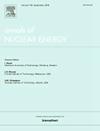Improvement on natural uranium utilisation in heavy water-moderated molten salt reactor using radial blanket
IF 1.9
3区 工程技术
Q1 NUCLEAR SCIENCE & TECHNOLOGY
引用次数: 0
Abstract
Heavy water moderated-molten salt reactor (HWMSR) is a novel concept in which heavy water is used as the neutron moderator in lieu of graphite. Excellent neutron economy of heavy water moderator allows HWMSR to use natural uranium as its fuel, foregoing the need for uranium enrichment. Studies regarding HWMSR typically assumes a single fluid stream with identical fuel conduit size throughout the core. This study expands that premise by analysing the performance of HWMSR fuelled by natural uranium with virtual one-and-half fluid stream, using 10% fuel volume fraction (VF) in the narrow fuel conduit and 22.5% fuel VF in blanket conduit. The variation ranges from no blanket until three outer blankets. Neutronic and burnup calculations were conducted using MCNP6.2 code and ENDF/B-VII.0 neutron cross section library. From the calculation results, it was observed that the temperature coefficient of reactivity (TCR) for all variations worsen over time, and only one variation remains negative until the end of cycle (EOC). Fuel cycle length in larger blanket layer numbers is significantly longer, better fertile conversion, and lower fissile consumption. The plutonium vector degraded quickly, so that it becomes impossible to divert. Overall, it is suggested that HWMSR that works using natural uranium be given larger blanket layer numbers to maintain safety and improving performance.
求助全文
约1分钟内获得全文
求助全文
来源期刊

Annals of Nuclear Energy
工程技术-核科学技术
CiteScore
4.30
自引率
21.10%
发文量
632
审稿时长
7.3 months
期刊介绍:
Annals of Nuclear Energy provides an international medium for the communication of original research, ideas and developments in all areas of the field of nuclear energy science and technology. Its scope embraces nuclear fuel reserves, fuel cycles and cost, materials, processing, system and component technology (fission only), design and optimization, direct conversion of nuclear energy sources, environmental control, reactor physics, heat transfer and fluid dynamics, structural analysis, fuel management, future developments, nuclear fuel and safety, nuclear aerosol, neutron physics, computer technology (both software and hardware), risk assessment, radioactive waste disposal and reactor thermal hydraulics. Papers submitted to Annals need to demonstrate a clear link to nuclear power generation/nuclear engineering. Papers which deal with pure nuclear physics, pure health physics, imaging, or attenuation and shielding properties of concretes and various geological materials are not within the scope of the journal. Also, papers that deal with policy or economics are not within the scope of the journal.
 求助内容:
求助内容: 应助结果提醒方式:
应助结果提醒方式:


